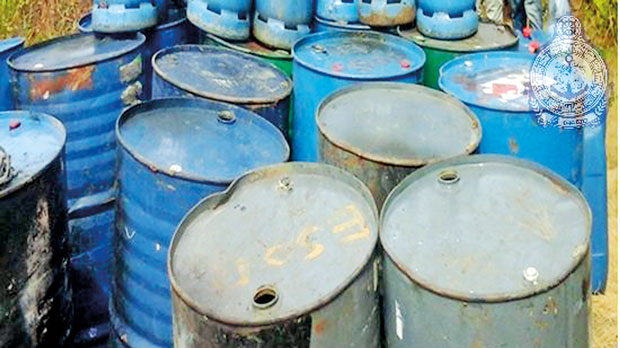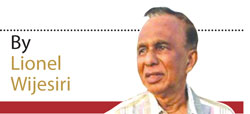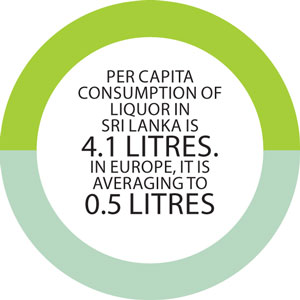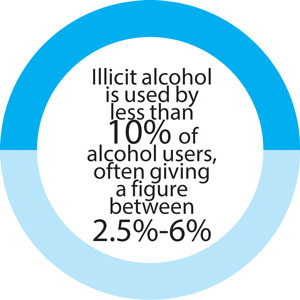05 Dec 2017 - {{hitsCtrl.values.hits}}

Other than legitimately produced alcohol we also have the serious issue of illicit alcohol
 “A nation of alcoholics!” is how a friend described Sri Lanka to me last night. I must say that even though I don’t want to be judgemental, I wish to express my opinion. I do agree with my friend in most ways.
“A nation of alcoholics!” is how a friend described Sri Lanka to me last night. I must say that even though I don’t want to be judgemental, I wish to express my opinion. I do agree with my friend in most ways.
Adult alcohol consumption has increased across the country, especially among the older Sri Lankans and people with lower levels of education and income. The rise is startling!
First, let us browse through some statistics.
The latest Excise Department report states that hard liquor production in Sri Lanka rose last year by 7.1 per cent. The ethanol imports for the manufacture of hard liquor has doubled from 10.4 million litres in 2013 to 20.4 million litres in 2015. The high levels were maintained in 2016 when 18.4 million litres were imported. These are legally imported figures.
The latest report issued by World Health Organisation titled – World Health Statistics 2017 (projected for 2016)– indicates said that the per capita consumption of liquor in Sri Lanka is 4.1 litres. In Europe, it is averaging to 0.5 litres.
Damage 
A few months ago, the Chairman of the National Authority on Tobacco and Alcohol (NATA) addressing the media said that a total of 35 percent of men and around 3 percent of women consume liquor in Sri Lanka. Cost wise, he said, the damage caused by alcohol consumption exceeds 140 billion per year.
What do these figures tell us? Before, we answer this question, we need to take a look at the other side of the coin – production of illicit alcohol.
Other than legitimately produced alcohol, we also have the serious issue of illicit alcohol. The Expert Committee on Tobacco, Alcohol, and Illicit drugs of Sri Lanka Medical Association (SLMA), said recently that inquiries made from the Police and Excise Officers and Divisional Secretaries as well as studies undertaken in different locations show that illicit alcohol production has reduced significantly during the last several years.
The committee said that technically sound sub-national studies have revealed that illicit alcohol is used by less than 10% of alcohol users, often giving a figure between 2.5%-6%.
Some professionals don’t agree with these figures.
Colombo University’s Economics Department Senior Lecturer Dr. Priyanga Dunusinghe, who carried out an independent research on the illicit alcohol market in the country said that 49 per cent of the quantity of total alcohol market was illicit liquor. He said the figure is comparable with the data already published by the World Health Organisation (WHO) and several other sources.

A professional presentation made by G.D.Dayaratne of the Institute of Policy Studies under the headline “State of the Sri Lankan alcohol Industry,” says “About 65 per cent of the total alcohol market in Sri Lanka is estimated to be illicit, with 30 per cent consisting of legal hard liquor and just 5 per cent of beer. Although this report was published in 2013, this writer doubts that dramatic changes happened between 2013 and now for any changes.
“What a pity,” I told my friend. “Why should you care?” he asked, “It’s one’s personal choice.”
Adverse effects
I disagreed. Alcohol costs adverse effects to the individual. It affects the entire body, including the brain, nervous system, liver, heart, and the individual’s emotional well-being. Just one or two drinks can cause blurred vision, slurred speech, slower reaction speed, impaired memory, and loss of balance. Short-term effects disappear when the individual stops drinking, but long-term alcohol abuse may cause chronic disorders that are serious and debilitating.
Alcohol is a factor in many motor vehicle crashes, falls, burns, drownings, suicides, homicides, sexual assaults, and transfers of sexually transmitted infections. So, alcohol addiction is no more a personal choice, but a national issue.
Beyond the health risks and potential harm, there is the more insidious aspect of peak booze - the mental baggage. A fair few of us are more dependent than we’d like to be on that glass of arrack or gin and tonic at the end of the day.
Because so many people enjoy socializing over alcohol, we seem to have turned a blind eye to the many drawbacks of drinking. Even though nearly 10 percent of Sri Lanka adult population struggles with alcoholism or problem drinking, Sri Lankans have a somewhat cavalier attitude toward alcohol.
Solutions
So, what can be done. For some people, staying within low-risk limits will be sufficient, whereas for some, it’s best to quit.
Care must be taken, therefore that more and more price increases don’t inadvertently push consumers towards the illegal market. Persistent crackdowns also don’t have any major impact. For example, Excise officers conducted over 32,700 raids last year for “excise crimes” but it is doubtful whether there was a reduction in illicit liquor supply. We need more in-depth research and analysis to improve our understanding of this market, legal and illicit both, which will allow Government to work with other stakeholders, including major Sri Lankan alcohol producers, to find targeted ways to mitigate harmful use of alcohol.
If our goal is to effectively reduce harmful drinking, including limiting the danger posed by illicit alcohol, we must approach the problem with an understanding of vulnerable consumer populations as well as the factors that can drive the illicit market’s growth.
Governments can also benefit by partnering with alcohol producers, international organizations such as WHO and local NGOs in developing educational materials and identifying other evidence-based best practices to limit harmful alcohol use. WHO recognized the benefits of a multi-stakeholder approach in its Global Strategy to Reduce Harmful Use of Alcohol.
More resources, more information and more engagement help find more (and more effective) solutions. Policymakers must take a comprehensive approach, informed by research, to reduce harmful drinking through the enforcement of effective laws and consumer education.
10 Jan 2025 21 minute ago
10 Jan 2025 1 hours ago
10 Jan 2025 2 hours ago
10 Jan 2025 4 hours ago
10 Jan 2025 4 hours ago